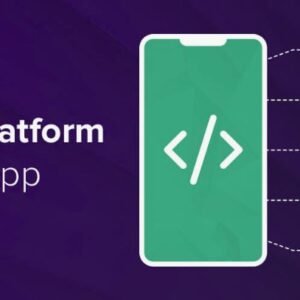What is a Cross-Platform App Development Framework?
A cross-platform app development framework allows developers to create applications that can run on multiple operating systems from a single codebase. Instead of writing different codes for iOS, Android, and other platforms, developers can use these frameworks to write code once and deploy it across various platforms. This approach saves time and resources, enabling faster development and easier maintenance. Cross-platform frameworks typically use languages like JavaScript, Dart, or C#, and they provide tools and libraries to bridge the gap between different operating systems. The key advantage is the ability to deliver a consistent user experience across multiple devices, ensuring broader reach and uniform functionality.
Popular Cross-Platform App Development Frameworks

Flutter
Developed by Google, Flutter is an open-source UI software development kit used to develop applications for Android, iOS, Linux, Mac, Windows, Google Fuchsia, and the web from a single codebase. It uses the Dart language and provides its own widgets, inspired by Material Design and Cupertino, allowing for beautiful, native-like experiences across platforms.
Key features:
- Hot Reload: Instantly see the results of code changes.
- Rich Widgets: Offers a comprehensive set of customizable widgets for building native interfaces.
- Dart Language: Uses Dart, which is easy to learn and offers robust performance.
- Single Codebase: Write once, run on multiple platforms including iOS, Android, web, and desktop.
- Strong Community Support: Extensive documentation and community-driven resources.
React Native
This framework, created by Facebook, allows developers to build mobile apps using JavaScript and React. React Native apps are compiled into natively rendered UI components, allowing developers to maintain a single codebase for both Android and iOS platforms. It leverages native components for high performance and is widely adopted due to its efficiency and extensive community support.
Key features:
- JavaScript-Based: Utilizes JavaScript and React, making it accessible to web developers.
- Reusable Components: Allows for reusable UI components across different platforms.
- Fast Refresh: See changes immediately during development.
- Large Ecosystem: Access to numerous libraries and third-party plugins.
- Backed by Facebook: Strong support and continuous updates.
Kotlin Multiplatform
Kotlin Multiplatform, an extension of Kotlin, enables developers to write shared business logic once and reuse it across multiple platforms while maintaining the ability to implement platform-specific features. It targets JVM, Android, iOS, macOS, Linux, Windows, and web, offering flexibility and reducing the time and cost associated with app development.
Key features:
- Shared Logic: Write business logic once and share it across platforms.
- Interoperable: Fully interoperable with Java, enabling integration with existing codebases.
- Native Performance: Generates native code for each platform, ensuring high performance.
- Tooling Support: Integrated with JetBrains’ IntelliJ IDEA, offering a rich development environment.
- Flexible: Can be incrementally adopted in existing projects.
Ionic
Ionic is an open-source UI toolkit for building performant, high-quality mobile and desktop apps using web technologies like HTML, CSS, and JavaScript. It is platform-agnostic, operates on a single codebase, and focuses on UI interaction. Ionic integrates seamlessly with Angular, React, Vue, or plain JavaScript, making it versatile for various use cases.
Key features:
- Web Technologies: Uses HTML, CSS, and JavaScript for app development.
- Cross-Platform: Build once, deploy on iOS, Android, and the web.
- Comprehensive UI Components: Provides a wide range of pre-designed UI components.
- Integration Capabilities: Easily integrates with popular frameworks like Angular, React, and Vue.
- Cordova Plugins: Access native device features through Cordova plugins.
.NET MAUI
.NET Multi-platform App UI (.NET MAUI) is a framework for building native mobile and desktop apps with C# and XAML. By extending the .NET platform, MAUI simplifies the development process across Android, iOS, macOS, and Windows. It provides a single project structure with multiple platform-specific implementations, emphasizing code sharing and productivity.
Key features:
- Unified Development: Single project structure for Android, iOS, macOS, and Windows.
- C# and XAML: Leverage the power of C# and XAML for UI design.
- Native Performance: Compiles to native code for each platform.
- Strong Tooling: Integrated with Visual Studio, providing robust development tools.
- MVU Pattern: Model-View-Update pattern support for building reactive UIs.
NativeScript
NativeScript is an open-source framework to develop apps on the Apple iOS and Android platforms. It allows developers to use JavaScript, TypeScript, or Angular to build mobile apps that convert the code to native APIs transparently, providing native performance and user experience.
Key features:
- Native APIs: Access to native APIs using JavaScript/TypeScript.
- Full Native Performance: Directly calls native code, ensuring high performance.
- Extensible: Supports Angular and Vue.js for building modern apps.
- Rich Plugins: Extensive library of plugins to extend functionality.
- Single Codebase: Write code once and run on multiple platforms.
Xamarin
Xamarin, a .NET-based framework, allows developers to build applications for Android, iOS, and Windows using C# and .NET libraries. It integrates deeply with Visual Studio, providing a rich development environment. Xamarin compiles code into native binaries, ensuring that the performance of the apps is comparable to those developed in native languages.
Key features:
- C# and .NET: Use C# and .NET to build native apps.
- Native Performance: Provides near-native performance.
- Comprehensive API Coverage: Access to all native APIs.
- Shared Codebase: Share up to 90% of code across platforms.
- Strong Tooling: Integrated with Visual Studio, offering excellent development tools.
Node.js
While primarily known as a JavaScript runtime for building server-side applications, Node.js is also used in mobile app development, particularly through frameworks like Meteor.js. It allows developers to build scalable and performance-efficient applications using a non-blocking, event-driven architecture.
Key features:
- JavaScript Runtime: Uses JavaScript for both server-side and client-side development.
- Event-Driven Architecture: Efficient, scalable handling of multiple connections.
- Rich Ecosystem: Access to a vast array of modules via npm.
- High Performance: Built on the V8 JavaScript engine for fast execution.
- Cross-Platform: Can run on various operating systems.
Appcelerator Titanium
Titanium SDK, by Appcelerator, enables the creation of mobile apps on platforms including iOS, Android, and Windows from a single JavaScript codebase. It offers direct access to native APIs and UI components, which helps in achieving a near-native user experience and performance.
Key features:
- JavaScript-Based: Uses JavaScript to create native apps.
- Native UI Components: Provides native UI components for better performance.
- Cloud Services: Built-in cloud services for push notifications, analytics, and more.
- Extensive API Coverage: Access to native APIs across different platforms.
- Modular Architecture: Allows for easy code reuse and maintainability.
PhoneGap
Now archived by Adobe and replaced by Apache Cordova, PhoneGap was a popular choice for developers looking to create mobile applications using HTML5, CSS3, and JavaScript. It wrapped web applications in a native container, allowing them to access device-specific hardware features.
Key features:
- Web Technologies: Uses HTML, CSS, and JavaScript for building apps.
- Plugins: Access to native device features through a wide range of plugins.
- Open Source: Community-driven and open-source framework.
- Ease of Use: Simple to set up and start building apps.
- Cross-Platform: Deploys on multiple platforms from a single codebase.
Sencha Touch
This was a product of Sencha, designed to build mobile web applications that look and feel like native applications on supported mobile devices. It was based on HTML5, JavaScript, and CSS3, providing a wide range of UI components and tools. Sencha Touch has now evolved into Ext JS.
Sencha Touch
- JavaScript Framework: Uses JavaScript and supports HTML5 for building mobile apps.
- Rich UI Components: Extensive collection of pre-designed UI components.
- Performance Optimizations: Optimized for touch devices for smooth performance.
- MVC Architecture: Supports MVC architecture for better code organization.
- Integration Capabilities: Easily integrates with various back-end data sources.
Corona SDK
Corona is a cross-platform framework ideal for creating games and apps for mobile, desktop, and even TV devices. It uses Lua, a lightweight and powerful scripting language, which offers a fast and easy learning curve for developing graphics-intensive applications.
Key features:
- Lua Language: Uses Lua for fast and easy scripting.
- 2D Game Engine: Optimized for 2D game development.
- Cross-Platform: Develop once and deploy on iOS, Android, and other platforms.
- High Performance: Offers high-performance graphics and physics capabilities.
- Extensive Plugin Support: Access to numerous plugins to extend functionality.
What Are the Benefits of Cross-Platform App Development Frameworks?

Cross-platform app development frameworks offer numerous benefits, including cost efficiency, faster time-to-market, and a broader audience reach. Developing a single codebase for multiple platforms reduces development and maintenance costs. It also speeds up the deployment process, allowing businesses to launch their products faster. Moreover, cross-platform frameworks ensure a consistent user experience across different devices, enhancing user satisfaction and engagement. They also provide access to a vast array of plugins and third-party tools, further extending the functionality and capabilities of the applications. Additionally, with a single team working on the project, collaboration and communication are streamlined, reducing complexities and potential misunderstandings.
How Do You Choose the Right Cross-Platform App Development Framework for Your Project?
Choosing the right cross-platform app development framework depends on several factors:
The Expertise of Your Team
Evaluate the skills and experience of your development team. Some frameworks might align better with their existing knowledge, reducing the learning curve and development time.
Vendor Reliability and Support
Consider the reliability of the framework’s vendor and the level of support they offer. Strong support and a robust community can be invaluable in resolving issues and ensuring the success of your project.
UI Customization
Assess the framework’s ability to deliver the desired UI customization and performance. Some frameworks offer more flexibility and control over UI design, which can be crucial for creating a unique user experience.
Framework Maturity
The maturity and stability of the framework are important. Established frameworks often have fewer bugs, better performance, and a wealth of resources and documentation.
Framework Capabilities
Ensure the framework supports all the necessary features and functionalities for your project. This includes access to native device features, third-party integrations, and scalability.
Security
Evaluate the security features and practices of the framework. Robust security measures are essential for protecting user data and ensuring compliance with regulations.
Educational Materials
Check the availability of educational materials, such as tutorials, documentation, and courses. Comprehensive resources can help your team quickly get up to speed with the framework.
Key Takeaways
- Cross-platform frameworks enable developers to build applications for multiple platforms using a single codebase.
- Popular frameworks include Flutter, React Native, Kotlin Multiplatform, Ionic, .NET MAUI, NativeScript, Xamarin, Node.js, Appcelerator Titanium, PhoneGap, Sencha Touch, and Corona SDK.
- Key factors in choosing a framework include team expertise, vendor reliability, UI customization, framework maturity, capabilities, security, and available educational materials.
- The benefits of cross-platform development include cost efficiency, faster time-to-market, broader audience reach, and a consistent user experience across devices.








